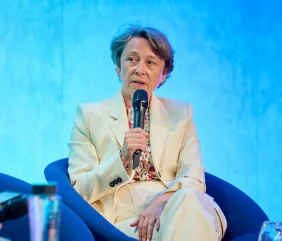
Pending rule changes around 4.25t electric vans need to be implemented to help stimulate demand for the vehicles, according to Ford’s UK chair and managing director.
Lisa Brankin said that Ford could quickly respond with larger electric van stock once the changes had gone through.
The UK Government has already removed a requirement for drivers of electric vans weighing between 3.5t and 4.25t to undergo additional training. However, other changes, such as exempting the vehicles from the MOT and tachograph requirements applied to heavier vehicles, are still to be implemented following a consultation.
Speaking at the BVRLA’s Fleets in Charge conference, Brankin said: “We’ve still got the issue that’s not fully resolved around 4.25t [electric vans]. Although there has been some give on licensing, we still don’t have the change on MOT and we still don’t have the change on tachographs.
“Those two things, if we have flexibility, that would help unlock a bigger range of our lineup that’s cost effective and practical for users to run.”
Speaking earlier at the same conference, the government’s Future of Roads Minister Lilian Greenwood gave a progress update on the issue.
She said: “We talked … at the consultation around removing some of those other barriers [to 4.25t EV adoption] like roadworthiness testing and the MOT testing, tachograph, and drivers’ hours requirements.
“We’ve heard you, the officials are working hard on a response to that consultation. Obviously, we need to consider what are the implications for safety, but we’re really committed to getting that work done at pace.”
Despite highlighting the 4.25t issue, Ford’s Brankin added that the company was not only seeing demand for small electric vans as things currently stood.
She said: “We’re actually seeing demand across our range. It very much depends by customer, what they want to do.
“What we’re seeing is a lot of demand from local councils, because they have got a demand on them to meet certain requirements whether they like it or not. Some of our customers who have made really bold environmental statements are really heavily into electrification.
“Small individual buyers, or what you would call in inverted commas a retail market – that’s been more and more challenging.”
Brankin also called for action to be taken around electric van charging infrastructure.
She said: “We’re behind the curve probably with charging infrastructure overall, and I think we’re definitely behind the curve in terms of infrastructure for commercial vehicles, but it’s not just public charging infrastructure – one of the challenges is around grid access and cost of accessing the grid.
“[These] are challenges that businesses need fixed, particularly when you look at depot charging, and I’m not sure whether there is a firm plan for that.
“In the Industrial Strategy the government talked about the cost of electricity, which I think is really a welcome acknowledgement that that is an issue, and they’ve talked about targeted support for business, which is great if you’re one of those businesses that get the targeted support.
“I think that cost of electricity, the cost of charging in the UK, the public charging infrastructure for commercial vehicles and access to grid, is still a really big issue that’s not fixed. It’s going to be another brick in making that commercial vehicle fleet electrify.”
Speaking earlier in the conference, Greenwood had outlined money being put towards charging infrastructure by the government, and recently-announced measures to ease planning rules.
She added: “We want to go further: cutting red tape, making it easier, quicker, and cheaper to install chargers. And, of course, ensuring those grid connections that allow the roll out of significant hubs.
“And we recently held a call for evidence on further changes that we can made to the planning and permitting regimes and will be responding to those as soon as we can.”





